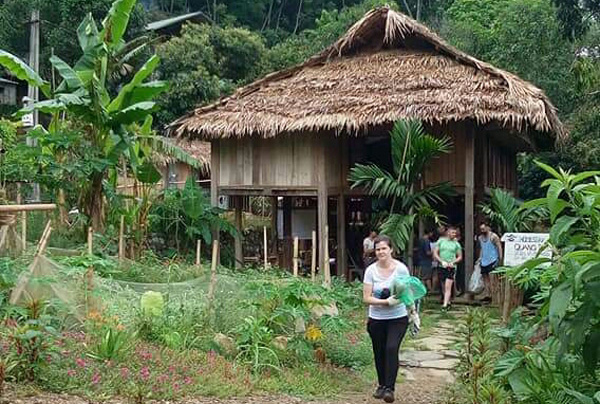
(HBO) - "The romantic landscapes of clouds and water is so poetic, charming, unique cultural identity, true emotion of the people living in the area of Hoa Binh Lake is a good choice for tourists in the country and abroad. The number of visitors from European countries coming to learn, experience the culture and nature of community tourism destinations, such as Sung village, Cao Son commune; Ke village, Hien Luong commune; Da Bia village, Tien Phong commune; Da Bac district has increased significantly"- the Director of Da Bac Tourism joint Stock Company Dinh Thi Thao announced.

The international visitors are visiting Da
Bia village, Tien Phong commune (Da Bac).
Da Bia village, Tien Phong commune is located
near the edge of Da River lake, there are dozens of Muong ethnic households
living. The cultural space and landscapes here, which is still almost original,
become the new and attractive destination for international tourists. Ms. Bui
Thi Nhem, the owner of Ngoc Nhem homestay said delightedly: the international
tourists mainly come from Europe. Almost every week there are international
visitors coming to the village. They go in groups of about ten or more, staying
overnight. They love to learn the cultural identity and the life of the local
people. The local people guide them on trekking to explore the jungle, rowing
at the bay, swimming and fishing on Da River. International guests do not
demand for the quality of service, they prefer the most of cultural identity of
walking, climbing, riding or exploring the jungle. Together with local people,
they harvest rice, fish, hunt, weave, knit; participate in the art performance,
bamboo pole dance, drinking Can wine with the local people", etc. Most
visitors have good feeling when visiting Da Bia village. The stilt houses, the
rhythm of bamboo pole dancing leave a good impression for international guests.
Homestay doers have learned English to communicate with international tourists.
At first, they can contact with common sentences such as introduction of the
village, home, asking about health and work, etc.
The activity of community-based tourism has
contributed to improving the lives of the villagers. Da Bia village has 40
households with 183 people, most of who have participated in community tourism.
At present, Da Bia has 4 community guest houses of Dinh Thu, Quang Tho, Ngoc
Nhem and Lakevie. The natural scenery and living habits of the villagers have
made good impressions to international visitors.
Up to now, Da Bac district has had nine
homestays, which are running business of welcoming visitors and in the first 6
months of 2018, the community tourism of Da Bac district has welcomed over
2,000 international visitors.
A diverse chain of eco-tourism and resort destinations concentrated in Hoa Binh city and the districts of Tan Lac, Da Bac, and Luong Son… Along with the launch of several key high-quality resort tourism projects, these developments have reshaped the landscape and enhanced the appeal of Hoa Binh as a travel destination.
Boasting diverse terrain, a mild climate, and rich natural resources, Cao Phong district is increasingly asserting its place on Vietnam’s tourism map, attracting both domestic and foreign visitors. The district is renowned for its stunning landscapes, majestic mountains, a crystal-clear hydropower lake, and the unique cultural identity of local ethnic groups.
With its pristine landscapes, unique cultural heritage of Muong ethnic minority, and an expanding range of visitor experiences, Tan Lac district of Hoa Binh has fast become a captivating destination for both domestic and international tourists.
Until now, Sung village in Cao Son commune, Da Bac district remains the only Dao ethnic community in Hoa Binh province to develop a community-based tourism model. Beyond its untouched natural landscapes, cultural identity serves as the cornerstone attraction for visitors.
Alongside the diverse cultural identities of the Kinh, Muong, Tay, Thai, Dao, and Mong ethnic people, Hoa Binh province is also renowned as the "capital" of the northwestern Vietnamese cuisine, offering unique and distinctive dishes. At festivals, during Lunar New Year (Tet), or on significant family or community occasions, special dishes are prepared, leaving a lasting impression on visitors.
A Phong Linh (Yellow Tabebuia) flower garden in Thang village, Thach Yen commune, Cao Phong district is currently in full bloom, drawing a large number of visitors.



